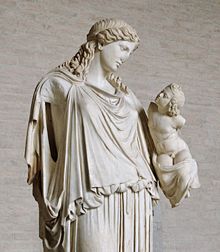- Cephisodotus the Elder
-
Cephisodotus or Kephisodotos (flourished about 400 - c. 360 BC[1]) was a Greek sculptor, perhaps the father or an uncle of Praxiteles, one of whose sculptor sons was Cephisodotus the Younger.[2]
The one noted work of his was Eirene (Peace) bearing the infant Ploutos (Wealth), ca 380-370 BC,[3] of which a Roman point copy exists at the Glyptothek, Munich (illustration, right) and fragments in various collections. The Eirene, commissioned by the city of Athens and set up on the Areopagus,[4] was attributed to Cephisodotus by Pausanias in the 2nd century AD.[5]
Cephisodotus also made, as did his son, a figure of Hermes carrying the child Dionysus, unless indeed ancient critics have made two works of one. He made certain statues for the city of Megalopolis, founded by Epaminondas in 369 BC; Pausanias noted them in the principal temple there in the 2nd century AD.
Two heads that were long thought to be feminine and inserted in female busts, one formerly in the Lansdowne collection[6] and the other in the Massarenti collection, Rome,[7] now recognized to be of Apollo, were attributed to Cephisodotus by Dorothy Kent Hill in 1974.[8]
Notes
- ^ Pliny places the elder Cephisodotus in the 102nd Olympiad, i.e. 371-368.
- ^ "Praxiteles' father's name is not recorded, "but, given Greek practice of handing down names and crafts in the family, it is likely that if not Praxiteles' father, he was a relation" (Martin Robertson, A Shorter History of Greek Art [Cambridge University Press) 1981, p. 138).
- ^ Dates as in H.K. Süsserott, Griechische Plastik des 4. Jahrhunderts vor Christus (1938) p 141f; the annual sacrifices to Eirene began with the in 371, Isocrates informs us
- ^ The Eirene was illustrated by Attic vase-painters on Panathenaic prize amphorae bearing the name of the archon for 360-359 (Robertson 1981, p. 139).
- ^ Pausanias, I.8.2 (notes the statue at Athens), IX.16.2 ("It was a clever idea of these artists to place Wealth in the arms of Fortune, and so to suggest that she is his mother or nurse. Equally clever was the conception of Cephisodotus, who made the image of Peace for the Athenians with Wealth in her arms").
- ^ The Lansdowne antiquities were dispersed at auction in 1930; the Lansdowne head was in the collection of William Randolph Hearst, donated to Los Angeles County Museum of Art, on loan to the J. Paul Getty Museum.
- ^ Sold in 1902 and now at the Walters Art Gallery, Baltimore.
- ^ Dorothy Kent Hill, "Apollo by Kephisodotos the Elder" The J. Paul Getty Museum Journal, 1 (1974:81-84); the two heads are different in scale and cannot be point copies of a single original (p. 81).
References
Categories:- 4th-century BC Greek sculptors
- Ancient Greek sculptors
- 5th-century BC births
- 4th-century BC deaths
Wikimedia Foundation. 2010.

